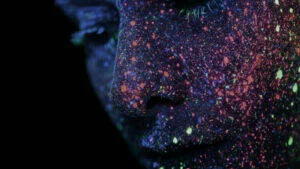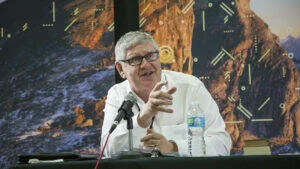“The future is known. It is the past that keeps changing.”
 Thank you, Hans, for your thoughtful Redirect. I think these questions further the conversation. If I interpret them correctly, your basic concerns are as follows: 1) Is the neo-Darwinian model (NDM) really being challenged, or simply supplemented? 2) Do these new developments in biology really point towards ID? 3) Is the debate at a point where ID theorists can move past critiquing the NDM and offer some kind of alternative framework?
Thank you, Hans, for your thoughtful Redirect. I think these questions further the conversation. If I interpret them correctly, your basic concerns are as follows: 1) Is the neo-Darwinian model (NDM) really being challenged, or simply supplemented? 2) Do these new developments in biology really point towards ID? 3) Is the debate at a point where ID theorists can move past critiquing the NDM and offer some kind of alternative framework?
The main thrust of my original essay was that the recent shift in the way we think about biology (i.e., the kinds of operational models we use to describe and understand it) has been away from the linear reductionism seen in the NDM, and towards views that largely align with what would be expected from an ID perspective. ID theorists have long been skeptical of the efficacy of the NDM. To my mind, this skepticism has now been richly supported by mainstream science, as evidenced by the ease with which Hans offers, “In the older neo-Darwinian tradition, attempts to explain macroevolution solely in terms of microevolution became increasingly unconvincing and, for many biologists, ultimately unsuccessful.” Within Christian circles, many biologists now suspect that the NDM has failed. Sy Garte recently titled his review of Michael Denton’s latest book, “Evolution is Still Not a Theory in Crisis, but Neo-Darwinism Might Be.”https://biologos.org/articles/evolution-is-still-not-a-theory-in-crisis-but-neo-darwinism-might-be. He has elsewhere written that the “The neo-Darwinian model . . . has proven limited and out of date with respect to several areas of biological research.” Joshua Swamidass has repeatedly made statements like, “Darwinism (as defined in ID) was definitively falsified by population genetics back in 1968.”https://discourse.peacefulscience.org/t/darwinism-falsified-in-science-long-ago/4325. Simon Conway Morris and a good many others have deemed the NDM insufficient. In fact, this is now a place where evolutionary creationists and ID theorists largely agree. Score one for the ID community. They were right to be skeptical.
Neo-Darwinism: Challenged or Changed?
But is the NDM being challenged and replaced, or simply augmented? To answer this, we have to consider what exactly the NDM is. Darwin’s original argument was grounded in the idea that natural selection could sort variation among individuals in a population in roughly the same way that artificial selection couldBut is the NDM being challenged and replaced, or simply augmented? To answer this, we have to consider what exactly the NDM is. (say, a breeder isolating and amplifying particular traits through controlled—intelligently determined—breeding). The only “selected” parameter in nature was thought to be fitness. If a trait helps you leave more progeny than your competitors, selection will eventually bring you to victory; at some point in the future, every individual in the population would have inherited that trait from you. We call this a selective sweep, leading to “fixation” of the trait in a species (i.e., it becomes a permanent evolutionary step).
The NDM unified this idea with twentieth-century molecular biology. Mutations to DNA (genes) led to changes in the form and function of an organism, and so we were really interested in modeling how natural selection could bring particular mutations (alleles) to fixation. By the 1960s the NDM also contained fixation of mutations by chance-based mechanisms (drift, founder effects, and neutral evolution), as opposed to natural selection. Separate two populations of pill bugs (Oniscus asellus), and they will become increasingly genetically divergent over time, even in the absence of selection. But, while genetically dissimilar, they would still just be pill bugs. It was thought that evolution in the absence of adaptive traits and natural selection could not build new structures and forms. Thus, much of the “adaptationist” construct provided by the NDM persisted as the assumed driver of meaningful (constructive) evolution.
This led to a calcified view of evolution that persists in some circles even today. Small mutations in DNA could lead to changes in phenotypes that affect fitness, allowing selection to work its magic. The process would be gradual. Complex structures had to be built up (and were therefore reducible to their component steps and parts).Franklin and Vondriska (2011) recently remarked, “Arguably the greatest postmodern coup for reductionism in biology was the articulation of the central dogma.” Circ Cardiovasc Genet 4:576. Deep divergence or large-scale phenotypic differences were presumed to stem from equally large differences in genetics (namely, lots of novel specialized genes would evolve in specific lineages to carry out novel specialized functions). This also led to the expectation that most of the eukaryotic genome would be a wasteland of “junk” DNA, produced by the trial-and-error mechanism outlined in the NDM. Again, essentially every one of these assumptions is in question, or has been outright rejected, today.
But what have we learned in the past two decades? Contra some harmonizing of the NDM with new findings, we read, “Evolutionary developmental biology offers a significant challenge to the neo-Darwinian paradigm.”M. D. Laubichler, “Evolutionary Developmental Biology Offers a Significant Challenge to the Neo-Darwinian Paradigm,” Contemporary Debates in Philosophy of Biology (2009): 199–212. The key word there is challenge. In a recent article, Gerd Müller observed, “A rising number of publications argue for a major revision or even replacement of the standard theory of evolution, indicating that this cannot be dismissed as the minority view but rather is a widespread feeling among scientists and philosophers alike.”G. B. Müller, “Why an Extended Evolutionary Synthesis Is Necessary,” Interface Focus 7 (2017). See also Kevin Laland’s commentary in “Does Evolutionary Theory Need a Rethink?,” Nature 514.9: 161–64. The key word there is replace. As reported earlier this year by Benjamin R. Dierker, “approximately one-third of professional academic biologists who do not believe in intelligent design find Darwin’s theory is inadequate to describe all of the complexity in biology.”B. R. Dierker, “Why One-Third of Biologists Now Question Darwinism,” The Federalist, April 16, 2019. https://thefederalist.com/2019/04/16/one-third-biologists-now-question-darwinism/
The Puzzle Persists
The Rubik’s cube of life hasn’t been solved by the reductionism of the NDM. In fact, W. Ford Doolittle and others advancing the Constructive Neutral Evolution (CNE) model not only concede that biological systems are complex and irreducible, but argue they are too complex and irreducible! For example, Lukes et al. (2011) wrote that CNE, “could lead to what we term ‘irremediable complexity’: the seemingly gratuitous, indeed bewildering, complexity that typifies many cellular subsystems and molecular machines.”J. Lukes, et al., “How a Neutral Evolutionary Ratchet Can Build Cellular Complexity,” Life 63.7 (2011): 528–37.
The fact of the matter is, here in the twenty-first century, “How body pattern evolves in nature remains largely unknown . . . there are few well worked out examples of how morphological features may be gained in natural species (constructive evolution).”P. A. Cleves, et al., “Evolved Tooth Gain in Sticklebacks Is Associated with a Cis-Regulatory Allele of Bmp6,” PNAS, 111.38 (2014): 13912-12917. In a recent article attempting to assimilate evo-devo with the so-called “extended evolutionary synthesis,” Fábregas-Tejeda and Vergara-Silva observed,
‘evolutionary biology is a notoriously diffuse field of scientific inquiry’ (Eldredge 2008; p. 10). Ten years after that statement, the idea seems to hold as the discipline comprises a plural landscape of multiple co-existent conceptual frameworks and strenuous voices that disagree on the nature and scope of ‘evolutionary theory.A. Fábregas-Tejeda and F. Vergara-Silva, “The Emerging Structure of the Extended Evolutionary Synthesis: Where Does Evo-Devo Fit in?,” Theory in Biosciences 137.2 (2018): 169–84.
Suzan Mazur recently offered,
Darwinian science is being marginalized by a growing number of responsible scientists. There’s a schism between the neo-Darwinists on one side and on the other many of the evo-devo scientists, symbiogeneticists, geologists, mechanical engineers, natural scientists, cognitive scientists, linguists and others.S. Mazur, “Is Life an ‘Artificial Category’?,” Astrobiology Magazine, June 11, 2012. https://www.astrobio.net/alien-life/is-life-an-artificial-category/
This is hardly the stuff of some theory on the level of Newton’s gravity or Einstein’s relativity. But, is this just an in-house discussion that doesn’t really need to consider ID? Like many of us in the ID community, Müller and those in the “third way of evolution”https://www.thethirdwayofevolution.com/ camp suspect that there is an ideological reticence at play in this discussion. Old habits die hard, and there remains a recalcitrant phalanx of Darwinists who are able to shout loudly and be heard (the Jerry Coynes and Kenneth Millers of the world). It’s important to remember just how knee-jerk alarmist some have become on this front. One has to chuckle at the 2011 Scientific American article titled, “Pssst! Don’t tell the Creationists, but Scientists Don’t Have a Clue How Life Began.” It’s clear that the specter of any intelligent designer lives rent free in the minds of many mainstream scientists.
But what are they so afraid of? Let us take stock of the facts in hand today. Gradualism is dead. Genomes function more like highly recursive intelligent operating systems than linear bottom-up mechanisms. “Core” gene regulatory networks are highly conserved, and show up very early in complex life. Junk DNA isn’t junk. Life—at multiple levels—is irreducible.Writing in Science in 1968, Michael Polanyi argued for “Life’s Irreducible Structure,” asserting that “living organisms are classed with machines . . . the morphology of living things transcends the laws of physics and chemistry,” and that they are not “reducible to the laws of inanimate matter.” Today, Walker and Davies have dubbed this the “Hard Problem of Life.” Every one of these (and others) are places where ID has turned out to be on the right side of science. But if we equate “science” with “materialism,” it becomes essential that biology be reducible to more basic processes, and explicable by natural (blind, unguided) laws. A mind is more complex (at least informationally) than the thing it creates. Absent intelligent agency as a creative force, the only recourse is to find a reductive bottom-up mechanism for producing what is now top-down, global, and non-linear. The hunt is on to imagine a model that can successfully get us from blind physical and chemical processes to simple—then complex and irreducible—life. If ID is to contribute more than basic predictions about what life should look like if it were intelligently designed, it must offer clear and testable mechanisms for creating the features we observe. Determining whether or not that is possible will be the next phase of the ID movement.







Comments
Be the first one to make a comment!